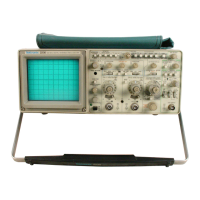Theory of Operation—2230 Service
Signal Ground
The AUXILIARY CONNECTOR SIG GND connection
(J1011 pin 9) is the ground point for all signal path ground
returns.
Pen-Down Circuit
The Pen-Down circuitry controls the pen mechanism of
an external X-Y plotter or the motor drive of a Y-T strip
chart recorder.
The Pen-Down circuit is comprised of operational
amplifier U1001B, transistor Q1012, relay K1001, and
related components. The PEN DWN signal (J6423 pin 1)
drives the non-inverting input of the operational amplifier
(U1001B pin 5). The inverting input of the operational
amplifier (U1001B pin 6) is tied to ground. The operational
amplifier output, U1001B pin 7, goes to the base of PNP
relay-drive transistor Q1012, through current limiting resis
tor R1005. This amplifier has no negative feedback
resistor and operates in an open-loop gain configuration.
Small input signals therefore drive the output near one rail
or the other. The output signal resembles a square wave,
regardless of the input waveform.
Transistor Q1012 inverts the signal and drives relay
K1001. Diode CR1016 protects the transistor from induc
tive kick-back voltages generated by the relay’s collapsing
magnetic field as the transistor turns off. Fuse FI 001, in
the RELAY COMM signal path, provides over-current pro
tection for all relay contact configurations.
When the PEN DWN signal on U1001B pin 5 goes
negative, the output on pin 7 of the operational amplifier
also goes negative, turning on transistor Q1012 and ener
gizing the relay coil. When the relay is energized, the relay
common to normally closed connection opens and the
relay common to normally open connection closes. When
PEN DWN returns to a positive level, the transistor shuts
off. The relay’s coil discharges its kick-back current
through diode CR1016, and the relay common returns to
its normally closed position.
In order to drive both an X-Y plotter and a Y-T strip
chart recorder, the Pen-Down circuitry does double duty.
With an X-Y plotter, the circuitry simply lowers the plotter
pen. with a Y-T strip chart recorder, the pen-down circuitry
is actually a motor drive control circuit. This double duty is
accomplished by providing the Pen-Down signal to the
operational amplifier about 1 s prior to the signals- being
provided to X & Y plot output circuitry. This allows the
motor to have time to start up before signals are applied
to the Y plot output circuit. The circuit can not differentiate
between X-Y plotters and Y-T strip chart recorders, there
fore the time delay from PEN DWN to X and Y channel
information output is the same in each case.
X and Y Amplifiers
The X and Y amplifiers drive the X and Y outputs.
Because both amplifiers operate the same, only the X-
PLOT amplifier is discussed in detail.
Input signal X PLOT goes to the non-inverting input of
unity gain amplifier U1001C pin 10. The output of the
operational amplifier is fed to auxiliary connector J1011
pin 3 through resistor R1002. The resistor limits the output
current and is part of the amplifier’s protection network.
The X-PLOT protection network consists of diodes
CR1003, CR1011, R1002, VR1012, and VR1011. If the X
output goes above 5.8 V peak, VR1011 and CR1011 turn
on, clipping U1001C pin 8 to about +6 V. If output goes
below —5.8 V peak, VR1012 and CR1003 turn on, clipping
U1001C pin 8 to about — 6 V. The Y-PLOT protection
components are CR1001, CR1002, R1001, VR1012, and
VR1011.
Power Supplies
The filters for all supplies are pi filters, consisting of two
filter caps to ground, one on each side of a series choke.
Each filter circuit for the three supplies filter in both
directions. The filters reduce noise on the power supply
lines generated elsewhere in the instrument, and they also
reduce noise generated by the X-Y plotter board as the
noise goes back out to the supplies in the rest of the
instrument. Capacitors Cl 003, Cl 004, and Cl 005 decou
ple and by-pass the supplies.
The +4.2 V output makes interfacing to various X-Y
and Y-T devices easier. The +5 Vg goes to the anode of
reverse voltage protection diode CR1014. The diode drops
the voltage to +4.2 V. The +4.2 V goes through current
limit resistor R1013 to the auxiliary connector output
(J1011 pin 6).
3-52

